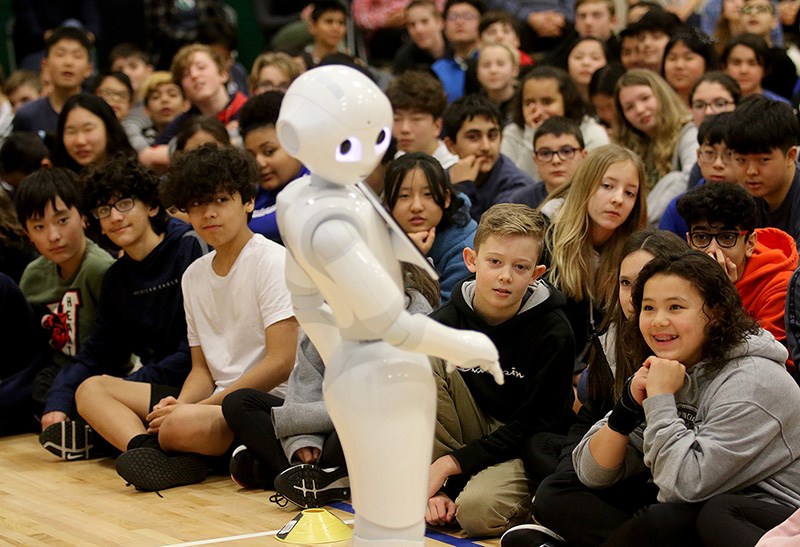School is going to look a little different in the Tri-Cities with the introduction of robots that can dance, talk and help kids learn to code.
With a “Hello Scott Creek,” a child-sized robot called Pepper, developed by Softbank Robotics, was introduced to a gym full of excited Scott Creek middle school students and teachers, plus representatives from Port Coquitlam's Finger Food Advanced Technology Group, which donated the robots and is creating programming software for students.
Wednesday, the 100-lb. machine was introduced to the cheering tweens while officials described how it will be used to teach middle and high school students the Applied Design, Skills and Technologies curriculum.
At Scott Creek, two of these sophisticated robots, worth more than US$20,000 each, will be used in the students’ Exploration class, with principal Lisa Rinke hopeful kids will be motivated to learn the skills they will need for jobs in the future.
“We are challenged with preparing you for a future that we don’t even know how it looks and for jobs that haven’t been invented yet,” Rinke told the students before commenting, “Pepper looks like she’s enjoying this” as the robot looked around the room with glowing eyes.
But behind the excitement of introducing the new technology is a serious effort to provide students a chance to work with a sophisticated piece of equipment.
Ten of these robots will be introduced to local schools, two each to Centennial and Pinetree secondary, two each to Scott Creek and Kwayhquitlum middle schools, with two more “roamers” in a partnership between SD43 and Finger Food, which is investing more than $265,000 in the initiative.
Using a block-based, drag and drop program developed by Finger Food for Softbank Robotics, SD43 will essentially test a program that could be subsequently used by schools around the globe.
“We are very excited to see what you are willing to learn and achieve with this,” said Graham Cunliffe, chief of strategy at Finger Food.
“And if anyone is coming to look for a job after working with these, come and see us,” he added.
The Pepper robots have been around for about five years and are more often seen in customer service roles, such as in doctors’ offices, greeting the public. They have sensors, microphones and a gyroscope, but also a degree of artificial intelligence — so-called machine learning.
And students who spoke to the Tri-City News expressed a keen interest in working with them.
Among the tasks the students would like to see the robots do is walk the principal’s service dog down the hallway, identify faces and greet students by name, maybe even ask them how their day is going or play Rock, Paper, Scissors.
“I think it’s exciting to be one of the first [students to use the robots],” said Saige Masse, a Grade 8 student, while Florence Therrien, also in Grade 8, said she’s interested in trying to program Pepper to do things.
Niko Kanagawa suggested it would be fun to teach Pepper to recognize letters in the alphabet and eventually get it to write a word on paper or a white board.
“I think everyone is excited in a robot that can walk around or say 'hello,'” Kanagawa said.
Stephen Whiffin told The Tri-City News the robots are being introduced to schools to teach students how to solve real-world problems using creative thinking, and are being distributed to schools needing a technology boost and where teachers have indicated an interest in incorporating them into lesson plans.
Training is being provided and the initiative will be reviewed to see if it’s successful, he said, noting SD43 will know Pepper is useful if it helps students “achieve those curricular goals.”
“It’s so you achieve curriculum success not just to have a robot,” Whiffin said.



